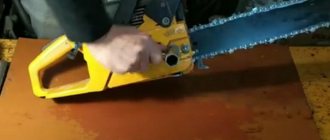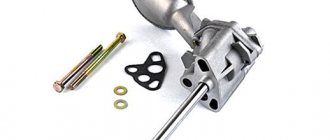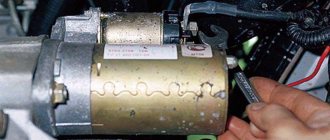Functions, structure and location of the VAZ 2110–12 oil pump
The engine lubrication system is designed to timely supply engine oil to the moving and hottest elements of the power unit. Oil is supplied from the sump and circulates through special channels inside the block and cylinder head. The oil pump ensures forced circulation of the lubricant.
Location of the oil pump on the VAZ 2110–12
On the VAZ 2110–12, the oil pump is located in the lower right corner of the cylinder block under the crankshaft gear, which drives the gas distribution mechanism.
The oil pump is located in the lower right corner of the engine under the crankshaft gear
This applies to both eight and sixteen valve engines. The pump housing is also the side cover of the power unit.
Oil pump device
The design of the oil pump is very simple and includes the following elements:
- housing with lid;
- driving and driven gears;
- pressure reducing valve with spring;
- oil receiver
The oil pump has a simple design based on two gears
Operating principle of the oil pump
The pump is driven by the crankshaft through the drive gear. The latter rotates the driven gear, creating a reduced pressure at the input of the device and increased pressure at the output. Thus, oil from the crankcase flows through the oil receiver tube into the pump, and from it into the engine oil line. When the pressure inside the pump begins to exceed the permissible value, a spring-loaded pressure relief valve drains excess oil back into the sump.
Dismantling works
In some cases, the structure needs to be replaced.
Sometimes it is enough to replace the gears and the pressure reducing valve of the VAZ 2110 oil pump will work normally.
Let's consider the sequence of work. First you need to remove the oil pump. To do this, you need to prepare an appropriate container for draining the engine oil. This procedure is best performed with a warm engine. After reaching the required temperature, you need to unscrew the drain hole and drain the liquid. In exceptional cases, car owners drain the lubricant “cold”. But, given the high viscosity of the lubricant, the procedure may take a long time. In addition, a significant portion of the oil will remain inside the crankcase. After this you need:
- unscrew the three bolts on the crankcase using a size 8 wrench. This must be done to get to the flywheel;
- Next you need to dismantle the flywheel protection. After this, the bolts are removed from the crankcase;
- at this stage you can dismantle the crankcase, which will provide access to the oil sump and crankshaft;
- the oil pump is located in this unit;
- Now the driver will need to move into the engine compartment. Here you need to remove the plastic protection covering the timing belt;
- the next stage involves dismantling the right wheel;
- then the pulley is removed. Next, you need to dismantle the timing belt;
- Using a 8 key, unscrew the 6 mounting bolts. They are the ones that secure the oil pump. Now you can remove the oil pump.
Tuning
The manufacturer AvtoVAZ provides a minimum of 50 hp for all its engines. s, so the 21124 engine can be modified in several ways:
- tuning of the cylinder block - boring of cylinders to 84 - 88 mm using ShPG of the appropriate sizes;
- tuning of the intake/exhaust tract – 4 throttles and “spider”, respectively;
- modification of the cylinder head - lightweight camshafts and split gear with appropriate tuning by a specialist;
- modernization of valves - replacement of standard equipment with lightweight T-shaped parts.
Separate throttle for each cylinder
Thus, engine 21124 is an improved version of the basic internal combustion engine 2112 with the volume, piston stroke and height of the cylinder block increased to 1.6 liters. The developers have ensured the interchangeability of parts from other engines from the AvtoVAZ manufacturer.
If you have any questions, leave them in the comments below the article. We or our visitors will be happy to answer them
Dismantling the cylinder head
You will also need to remove the timing belt - there are no differences between different engines.
Let's look at how the exhaust manifold can be detached from the cylinder head. On engine 21120:
- Remove the exhaust pipe of the muffler: unscrew two nuts 1 (key “13”), remove the clamping bar, unscrew six nuts 2 (key “14”) and dismantle, not forgetting to turn off the oxygen sensor. The photo shows three of the six nuts.
Elements of the exhaust pipe
Everything important is under the screen
Now we will talk about engine 21124:
- Disable both oxygen sensors. We unscrew the three nuts securing the protective screen (with a 10mm wrench) and disassemble the bracket by unscrewing the four nuts with a 13mm wrench.
How to disassemble the mounting bracket
Operation with additional muffler
Here we believed that the VUT hose was disconnected from the intake module. Finally, the spark plugs are unscrewed on any of the engines (a “16” tubular wrench).
The tightening torques for the mounting screws are given in another text. In general, on VAZ-2112 hatchbacks, cylinder head repairs begin by replacing the “extended” screws with new ones. The length should be 95mm or less.
The order of unscrewing (left) and tightening the mounting screws
Troubleshooting
Direct connection of the pump to the crankshaft avoids damage associated with its drive. This, however, does not exclude the possibility of other malfunctions.
Pump malfunctions and their symptoms
The main malfunctions of the VAZ 2110–12 oil pump include:
- clogging of the oil receiver mesh;
- damage to the device body;
- wear of gear seats in the housing and cover;
- wear of the drive or driven gear;
- damage to the pressure reducing valve;
- deformation or damage to the valve spring.
A constantly burning warning light in the form of an oil can indicates a drop in pressure in the lubrication system to a critical level
Signs of oil pump failure may include:
- critical oil pressure warning light on the dashboard;
- engine overheating;
- high-frequency knocking (clattering) at the pump location.
The design of the VAZ 2110–12 engine does not provide for the installation of an oil pressure sensor. Like most modern cars, representatives of the tenth family are equipped only with an emergency (critically low) pressure sensor. When the pressure in the system drops, a warning light in the form of a red oil can lights up on the instrument panel. However, this lamp can also light up in the event of other malfunctions (failure of the sensor, break in its electrical circuit, oil leak, etc.).
Engine overheating also cannot be attributed only to symptoms of a faulty oil pump. It usually occurs due to problems in the cooling system.
As for the knocking coming from the oil pump, not everything is clear here either. Sometimes, when gears or housing elements wear out, the device may produce a high-frequency knocking sound. As a rule, it is associated with the formation of play between the gears and the housing (cover) and is most clearly audible at idle. However, similar sounds can also be produced by worn bearings (tension or guide rollers, pumps, crankshafts).
How to determine that the oil pump is faulty
The process of replacing the oil pump on a VAZ 2110-12 is quite simple and does not involve the use of any special tools. However, to do this you need to buy a new pump and spend some time. Therefore, before replacing the device, you should make sure that it is the one that is faulty. This can be done using the following algorithm.
Oil level measurement
First you need to measure the oil level in the engine and check its consistency. This is done with a special probe. It is advisable to remember when the oil and filter were changed. If the car has traveled more than 10 thousand km since the last replacement, it is better to replace them immediately. Then you should apply a drop of oil to your thumb and rub it with your index finger. If the oil turns out to be too dark, liquid and quickly absorbed, it needs to be replaced.
If the lubricant level on the dipstick is below o, add oil and start the engine. Next, you need to see if the warning light on the dashboard comes on. You should also check whether the power unit is overheating. At the same time, the engine is inspected for oil leaks. If you previously heard a knocking sound from the pump, you should listen to see if it disappeared after adding oil.
One of the reasons for the drop in oil pressure in the system may be its low level
Checking the sensor electrical circuit
If the listed symptoms do not disappear, you should do the following:
- Stop the engine and let it cool.
- Disconnect the wire from the emergency oil pressure sensor. On sixteen-valve engines it is located on the left side at the end of the camshaft bearing housing, on eight-valve engines it is located on the right on the rear side of the cylinder head.
- Turn on the ignition without starting the engine.
- In the engine compartment, short the wire going to the sensor to vehicle ground. If the warning light goes out, everything is fine with the sensor circuit.
To check the sensor circuit, it is enough to short-circuit the wire going to it to ground with the ignition on
Sensor diagnostics
To diagnose the sensor, you need to unscrew it with a 21 key and inspect its working part, which goes into the cylinder head. There should be traces of engine oil on it, indicating normal lubricant circulation in the system. If the working part is dry, the oil pump is most likely faulty.
The sensor itself is usually checked by replacing it with a known good one. After this, it is checked whether the warning light is on and how the engine behaves.
Checking oil pressure
If after checking and replacing the sensor the symptoms do not disappear, you need to measure the oil pressure using a special pressure gauge. This pressure gauge has a metal tip with a thread that is screwed into the sensor socket. Then the engine starts and warms up. If the pressure gauge shows a pressure greater than 0.6 bar (60 kPa) at idle, the oil pump is working. If the pressure is lower, the pump should be replaced.
The oil pressure at idle speed must be at least 0.6 bar (60 kPa)
Checking the oil pump on the stand
In a car service center, the oil pump is checked on a special stand. This implies:
- determination of pump performance;
- measuring oil pressure at the pump outlet;
- measuring the pressure at which the pressure reducing valve opens.
In this case, special oil is used, the temperature of which should be exactly 200C. The performance of the VAZ 2110–12 pump at a crankshaft speed of 6000 rpm must be at least 35 l/min, and the pressure relief valve must open when the pressure inside the pump increases to 0.55–0.75 MPa.
When to change the oil
This question is quite important and this work should be done according to certain rules. You shouldn’t simply replace it every certain period of time. You just need to do this on time:
- It is recommended to change the oil for the VAZ 2112 after a mileage of about 8,000 or 10,000 km. But this again depends on operating conditions (long idling - winter periods), it is recommended to change the VAZ 2112 oil at lower mileage. A dark color of the oil, as a rule, will signal the need for this procedure; this indicates that combustion products are present in the oil, and accordingly will negatively affect the performance of the oil (washing out combustion products and mechanical wear, heat removal and transfer, lubrication) .
- Changing the oil on a VAZ 2112 must be done after a trip, until the engine has cooled down. If the engine is cold, you need to start it and warm it up to operating temperature. This must be done in order to reduce the viscosity of the oil in order to drain it as completely as possible from the crankcase.
Attention: When replacing, it is necessary to use the same brand of oil and fill in the oil that was previously in the engine. If you decide to change it to another, you will need to select an oil that is acceptable for this engine. Since in certain cases, when mixing oils of different manufacturers and names, it may foam and, accordingly, the main performance qualities are lost (heat removal of wear and heat products, lubrication). If you still decide to change the brand of oil, you should flush the engine lubrication system with flushing oil or the oil that will be used.
- If you are changing the fluid, after draining the old oil, you must fill in new oil to the lower oil level mark. Start the engine and let it idle for ten minutes. Drain the oil and only then change the oil filter. Now you can safely fill in new oil to the required level. If the minimum level is on the dipstick, there is a risk of insufficient pressure and lubrication, and overheating is also possible. If, on the contrary, the maximum level, then this can result in squeezing out the seals and causing a leak through them.
On our website you can find many detailed photos, as well as videos in which you can examine the processes in detail. Below are detailed instructions on how to change the oil in a VAZ 2112 with your own hands.
Oil pump VAZ 2112 16 valves
Post by Grigoryich » May 29, 2012, 1:41 pm
radiont625, Some service stations have a special adjustable wrench.
To deceive clients!
Nothing is adjustable in the oil pump.
We will never get what we want until we are grateful for what we have!
Osim haim!
Post by MaximV » May 29, 2012, 01:57 pm
Post by Grigoryich » May 29, 2012, 2:13 pm
We will never get what we want until we are grateful for what we have!
Osim haim!
Post by radiont625 » May 29, 2012, 2:15 pm
Is it possible to adjust it with a pressure reducing valve?
Added after 4 minutes 7 seconds:
The thing is that the oil pump is new, I also changed the oil receiver, the sensor is working, I can’t understand the reason. When it’s cold it doesn’t light up, when it warms up it starts blinking, the oil is in the middle of the mark
Post by Grigoryich » May 29, 2012, 2:29 pm
We will never get what we want until we are grateful for what we have!
Osim haim!
Post by radiont625 » May 29, 2012, 2:41 pm
Post by Grigoryich » May 29, 2012, 2:53 pm
There are so many of them, starting with general engine wear. N: in your case, it is most likely: low viscosity oil (I probably replaced it when changing the pump), or air leakage at the junction of the oil receiver and the pump (the ring was torn during installation, it did not fit correctly, or an old one was installed).
There are two methods for changing the oil
Changing the oil in a VAZ 2112 with engine flushing
After the old oil is drained, flushing oil is poured into the engine and the car is idled for about 10 minutes, after which the flushing oil is drained and new engine oil is poured in (the disadvantage is that the remains of the flushing oil remain and as a result they can cause engine operation have a negative impact). Since then the remains of the flushing oil will be mixed with the working oil, and the properties and tasks of these oils are different, which will accordingly have a negative effect on the performance characteristics.
Changing the oil in a VAZ 2112 without flushing the engine
After draining the old oil, new engine oil is immediately poured in (the disadvantage is that the remnants of used engine oil with the presence of combustion products will mix with the new engine oil, thereby reducing the working life of the oil).
Why do you need oil at all?
I often hear that oil is the lifeblood of the engine. This is not entirely true, of course, the comparison is very rough, but still, the engine will not function without oil (or it will, but not for a very long time).
Modern motor oils lubricate and protect all rubbing parts, and these are pistons (with their rings), shafts, bearings, etc. Let's just say that good oil extends the life of the engine by many thousands of kilometers.
BUT oil must flow through the system, just like blood itself through human vessels, if the oil is simply poured in a pan and does not go to the rubbing parts - IT IS USELESS!
Why is an oil pump needed?
Appearance of the pump
The oil pump in the engine is designed to build up pressure in the oil system, for the necessary lubricating effect of all rubbing parts of the internal combustion engine. If the pressure in the system is insufficient, the lubrication effect will be ineffective, which in turn will lead to the engine being unsuitable for operation. In this case, the low oil pressure warning light on the instrument panel should light up. Therefore, you should not delay repairing the oil pump.
You are left with two options. Take the car to a service station and lose a lot of time and money, or change the oil pump yourself.
Pump diagnostics
Oil pump removed for diagnostics. Symptoms: oil leak.
First, you need to make sure that the oil pressure sensor itself is working properly - check whether the sensor itself is dry or oily.
Secondly, you need to check whether power is supplied to it correctly or whether a wire is broken somewhere. And only after these procedures, if the light does not go out, will you have to change the oil pump.
Why might it break prematurely?
An oil leak from the oil pump can lead to expensive engine repairs.
Replacement of the oil pump can also be caused by poor quality oil, which will lead to rapid clogging of the oil receiver grid and subsequent lack of oil pressure in the system. It is not uncommon for an oil pump to become wet and oil to leak from underneath it. In these cases, you can get by by replacing the gasket and cleaning the oil receiver mesh.
System oil pressure
Oil pump cover
Stable oil pressure and temperature are the main factors for optimal engine performance
A prerequisite for normal engine operation is the constant maintenance of stable oil pressure and temperature. If overheated, the lubricant may lose viscosity and lose the basic physical characteristics necessary for the formation of an oil film, which is why many engines use a lubricant cooling system with an oil cooler and a temperature sensor. The oil radiator can be either liquid-cooled or air-cooled.
Maintaining a minimum pressure in the system is important to fully supply the entire line with oil, regardless of the degree of distance from the oil pump. Also for supplying lubricant through narrow and long channels of the cylinder block, cylinder head, crankshaft and camshaft and connecting rods
The pressure is controlled by a sensor that is installed in the lubrication system and transmits the pressure level to the dashboard, and also transmits pressure data to the engine control unit. If the critical pressure is insufficient, the control unit turns off the engine to avoid oil starvation.
The main reasons for oil pump failure
The service life of the VAZ 2110–12 oil pump regulated by the manufacturer is 150–200 thousand km. This, however, does not mean that the pump will not last longer or fail much earlier. The main reasons why it may stop functioning normally are:
- spent resource;
- untimely replacement of the oil filter, as a result of which metal particles (friction products) enter the system, acting on the pump parts as an abrasive, and the filter mesh of the oil receiver becomes clogged;
- use of oil whose characteristics do not meet the requirements of the car manufacturer.
How to check pressure
If, after diagnosing and replacing the sensor, the symptoms do not disappear, you can measure the pressure using a special pressure gauge. This device has a metal tip and a thread. It must be screwed into the socket instead of the sensor.
Then I need to start and warm up the engine. If the arrow on the pressure gauge shows a pressure above 60 kPa, we can talk about the serviceability of the oil pump. In the same case, if the pressure is below this value, the pump needs to be replaced or repaired.
Oil filter
The filter is full-flow, non-separable, screwed onto the fitting of the cylinder block and connected by channels to the oil pump and the main oil line. To remove the filter, use device A.60312. When installing the filter, it is recommended to wrap it manually without a tool. A filter element made of special cardboard is installed in the steel filter housing. The filter has anti-drainage and bypass valves. The anti-drainage valve does not allow oil to drain from the system when the engine is stopped, the bypass valve allows oil to pass through when the filter element is clogged from the pump into the main oil line.
Step-by-step instructions for replacing the pump on a Lada-Priora car yourself
It should be noted that it is impossible to replace the water pump on a Lada-Priora car without dismantling the engine generator drive.
Required Tools
When replacing the water pump on a Lada Priora car, you will need the following tools:
- open-end wrenches No. o10, No. o15, No. o17;
- spanners No. o15, No. o17;
- Allen key No. o5;
- two screwdrivers of different sizes;
- a specially designed wrench for installing the tension roller or a puller for retaining rings;
- Torx T-30 wrench used to remove the five screws that secure the front upper timing cover;
- mounting blade.
Assembly
Tip: When the pump is removed, we recommend replacing the front crankshaft oil seal located in the cover. We assemble the pump in the reverse order of disassembly. The driven gear inside the pump is positioned so that its side with chamfers and a mark is attached to the housing. The same with the drive gear. That's all. The pump assembly is completed, all that remains is to install it in place, as our instructions say. In addition to the instructions, we recommend watching a video on this issue. If a red indicator lights up on your instrument panel, signaling a lack of oil pressure in the system, then do not rush to run to the store and buy a new oil pump. The video discusses the most basic reasons why oil pressure may drop in a VAZ engine:
Filming
- First you need to disconnect the negative cable from the battery.
- Draining the oil from the engine
- We take out the camshaft drive belt
Attention. After removing the timing belt, you should not turn the crankshaft or camshaft, otherwise the valve pistons will be bent, in which case you will add more repair work and the cost will increase significantly.
- We take out the crankshaft toothed pulley, then its key, using two flat-head screwdrivers.
- Then remove the oil sump.
- Unscrew the oil intake mount.
- Using a 10mm socket with a ratchet and an extension, unscrew the six bolts securing the oil pump to the cylinder block.
- Remove the unit from the engine.
Note. There is a sealing gasket between the cylinder block and the oil pump.
- Be sure to wash the new oil pump with gasoline to remove grease for preservation.
- We fill it with oil before installation so that it does not rotate dry when starting.
- It is also important to turn the drive gear in order to place the pump on the crankshaft: so that the protrusions on the gear coincide with the groove on the crankshaft.
- Lubricate the seal lip with oil before putting the pump back.
- Carefully tuck the working edge of the oil seal onto the shaft journal using a wooden stick.
- Be careful and attentive when tightening the bolts so as not to strip the threads.
- Proceed in reverse order, install the remaining parts.
As can be seen from the above, this is not such a difficult job. The main thing for her is to approach it correctly and creatively. After all, proper lubrication is the basis for the longevity of a car.
What value should it be?
To begin with, it is worth noting that pressure is measured in bars (BAR), because we are measuring liquid. It’s unlikely that anyone will tell you the exact values now, because the structures of the engines are different, but there is a certain normal interval.
AT idle speed it is 2 BAR (or 0.2 MPa), for most cars
At 4000 - 5000 rpm - this is 4.5 - 6.5 BAR (0.45 - 0.65 MPa), also for most brands
If we take our VAZ 2112 16 valve version, then the pressure at idle is slightly higher, about 1.5 - 2.5 BAR. But at 4000 - 5000 rpm 0.4 - 0.6 BAR.
Actually, I’ll end here, I think the information was useful, read our AUTOBLOG.
( 4 votes, average: 2.75 out of 5)
Similar news
Why do you close the radiator in winter? Let's say with cardboard, the necessary knowledge
Mileage 100,000-150,000 km. Is it a lot or a little, what needs to be changed? Ra.
OTTO cycle. ATKINSON. MILLER. What is it, what are the differences in ra.
Add a comment Cancel reply
Comments
Good day everyone, I decided to write my review of the 2010 Toyota Avensis. Just want…
TOP articles for the month
I have many different articles and videos on various gearboxes, for example here...
I already have an article on the website about choosing memory cards (you can see it here), it’s very...
In the article - is it possible to open windows when the air conditioner is running (you can read it here), I was asked...
Why do many people turn to Auto Service Close when replacing the oil pump on a LADA (VAZ) 2112?
Our car services have been providing oil pump replacement services in Moscow for many years and have long managed to prove consistently high quality of service. Many motorists trust our specialists to replace the oil pump due to the following features of our service stations: Share: No comments
Engine oil pump, a device necessary for injecting oil from a running engine, which is under pressure to the moving surfaces of the engine mechanisms. It is designed to increase the pressure in the internal system of the engine, and is thus used to provide lubrication to all operating parts of the internal combustion engine.
ContentsPriceFaultsReplacement









